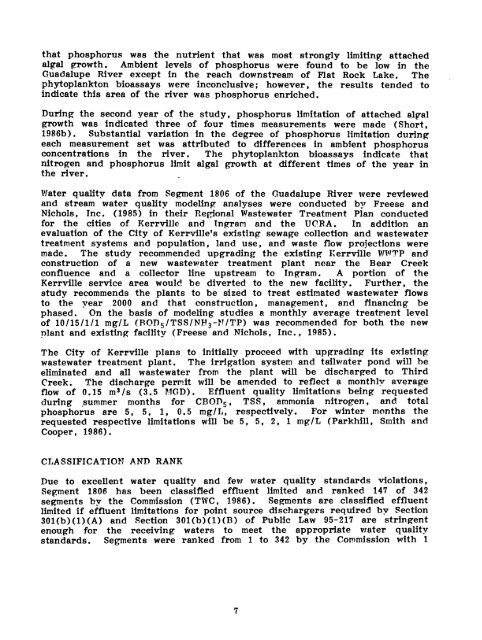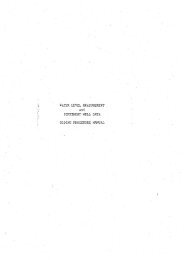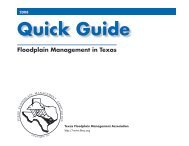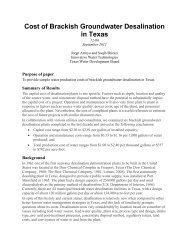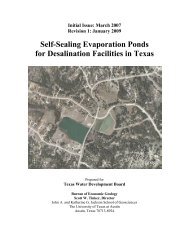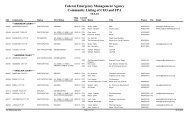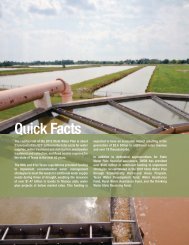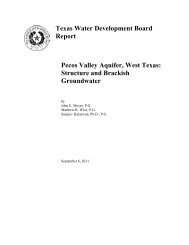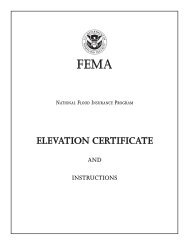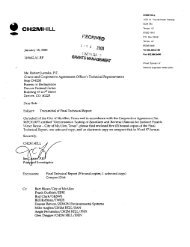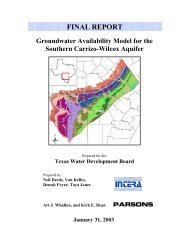Intensive Survey of the Guadalupe River Segment 1806
Intensive Survey of the Guadalupe River Segment 1806
Intensive Survey of the Guadalupe River Segment 1806
You also want an ePaper? Increase the reach of your titles
YUMPU automatically turns print PDFs into web optimized ePapers that Google loves.
that phosphorus was <strong>the</strong> nutrient that was most strongly limiting attached<br />
algal growth. Ambient levels <strong>of</strong> phosphorus were found to be low in <strong>the</strong><br />
<strong>Guadalupe</strong> <strong>River</strong> except in <strong>the</strong> reach downstream <strong>of</strong> Flat Rock Lake. The<br />
phytoplankton bioassays were inconclusive; however, <strong>the</strong> results tended to<br />
indicate this area <strong>of</strong> <strong>the</strong> river was phosphorus enriched.<br />
During <strong>the</strong> second year <strong>of</strong> <strong>the</strong> study, phosphorus limitation <strong>of</strong> attached algal<br />
growth was indicated three <strong>of</strong> four times measurements were made (Short,<br />
1986b). Substantial variation in <strong>the</strong> degree <strong>of</strong> phosphorus limitation during<br />
each measurement set was attributed to differences in ambient phosphorus<br />
concentrations in <strong>the</strong> river. The phytoplankton bioassays indicate that<br />
nitrogen and phosphorus limit algal growth at different times <strong>of</strong> <strong>the</strong> year in<br />
<strong>the</strong> river.<br />
Water quality data from <strong>Segment</strong> <strong>1806</strong> <strong>of</strong> <strong>the</strong> <strong>Guadalupe</strong> <strong>River</strong> were reviewed<br />
and stream water quality modeling analyses were conducted by Freese and<br />
Nichols, Inc. (1985) in <strong>the</strong>ir Regional Wastewater Treatment Plan conducted<br />
for <strong>the</strong> cities <strong>of</strong> Kerrville and Ingram and <strong>the</strong> UGRA. In addition an<br />
evaluation <strong>of</strong> <strong>the</strong> City <strong>of</strong> Kerrville's existing sewage collection and wastewater<br />
treatment systems and population, land use, and waste flow projections were<br />
made. The study recommended upgrading <strong>the</strong> existing Kerrville WWTP and<br />
construction <strong>of</strong> a new wastewater treatment plant near <strong>the</strong> Bear Creek<br />
confluence and a collector line upstream to Ingram. A portion <strong>of</strong> <strong>the</strong><br />
Kerrville service area would be diverted to <strong>the</strong> new facility. Fur<strong>the</strong>r, <strong>the</strong><br />
study recommends <strong>the</strong> plants to be sized to treat estimated wastewater flows<br />
to <strong>the</strong> year 2000 and that construction, management, and financing be<br />
phased. On <strong>the</strong> basis <strong>of</strong> modeling studies a monthly average treatment level<br />
<strong>of</strong> 10/15/1/1 mg/L (BOD5/TSS/NH3-N/TP) was recommended for both <strong>the</strong> new<br />
plant and existing facility (Freese and Nichols, Inc., 1985).<br />
The City <strong>of</strong> Kerrville plans to initially proceed with upgrading its existing<br />
wastewater treatment plant. The irrigation system and tailwater pond will be<br />
eliminated and all wastewater from <strong>the</strong> plant will be discharged to Third<br />
Creek. The discharge permit will be amended to reflect a monthly average<br />
flow <strong>of</strong> 0.15 m3/s (3.5 MGD). Effluent quality limitations being requested<br />
during summer months for CBOD5, TSS, ammonia nitrogen, and total<br />
phosphorus are 5, 5, 1, 0.5 mg/L, respectively. For winter months <strong>the</strong><br />
requested respective limitations will be 5, 5, 2, 1 mg/L (Parkhill, Smith and<br />
Cooper, 1986).<br />
CLASSIFICATION AND RANK<br />
Due to excellent water quality and few water quality standards violations,<br />
<strong>Segment</strong> <strong>1806</strong> has been classified effluent limited and ranked 147 <strong>of</strong> 342<br />
segments by <strong>the</strong> Commission (TWC, 1986). <strong>Segment</strong>s are classified effluent<br />
limited if effluent limitations for point source dischargers required by Section<br />
301(b)(1)(A) and Section 301(b)(1)(B) <strong>of</strong> Public Law 95-217 are stringent<br />
enough for <strong>the</strong> receiving waters to meet <strong>the</strong> appropriate water quality<br />
standards. <strong>Segment</strong>s were ranked from 1 to 342 by <strong>the</strong> Commission with 1


